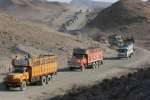- Text size
 |
|  |
|  |
| 
- Français
Poor weather, conflict exacerbate dire situation for Somali civilians
News Stories, 11 November 2011
NAIROBI, Kenya, November 11 (UNHCR) – Continuing conflict and bad weather in Somalia are further aggravating the dire humanitarian situation in Somalia. UNHCR staff in the south-western border town of Dobley say fewer refugees are crossing into Kenya. Rains which have made roads impassable and fear of being caught up in conflict are being cited as the main reasons.
In Dobley itself, which is just 18 kilometres from the border, people are continuing to arrive. They say they fled rumored impending military clashes in the area, and threats of forced return by the Al Shabaab militia to their places of origin.
Last weekend, six trucks containing almost 180 displaced people from Afgooye district arrived in Dobley after travelling for 27 days on flooded roads. They said that they had been instructed by Al Shabaab to return to their farms but opted instead to travel to Dobley in search of humanitarian help.
In Mogadishu, UNHCR, in conjunction with partner agencies, is finalizing an assessment of the internally displaced population in the Somali capital. The assessment mapped the location of settlements for internally displaced people (IDP) and obtained basic demographic and household size data.
GPS coordinates of all settlements in 14 of Mogadishu's 16 districts were recorded (two were not accessible for security reasons) and a survey of 7,000 households was undertaken.
The preliminary results reveal that there are almost 300 IDP settlements of varying sizes, with GPS sweeps of two districts yet to be completed. The cumulative Mogadishu IDP population figure will be presented to Transitional Federal Government officials in Mogadishu next week before being shared with the humanitarian community.
Meanwhile, a UNHCR-supported report launched yesterday in Nairobi looks into civilian harm caused by the military conflict in Somalia and the means by which it can be addressed. It focuses on assistance for civilians harmed in warfare. There is currently no international legal obligation for parties to conflict to make amends to civilians adversely affected by military operations.
Among the recommendations in the report – "Civilian Harm in Somalia: Creating an Appropriate Response" – is the establishment of a mechanism to track, analyze, investigate and respond to all incidents of civilian harm. The report also calls for all parties to the conflict in Somalia to immediately cease attacks targeting civilians and humanitarian agencies.
UNHCR stresses the moral imperative of compensating civilians for losses of property, limb or life due to military activities. It also calls upon donors to provide the necessary financial support to fund implementation of the recommendations in the report, so that an effective policy on making amends can be established by the African Union Mission in Somalia (AMISOM).
The report was compiled by the non-governmental organization CIVIC from more than 100 interviews with Somali civilians, humanitarian agencies, the UN and international donors and African Union Mission in Somalia personnel between February and July in Mogadishu, the Dadaab refugee complex, and among the Somali diaspora.
- CIVIC report: "Civilian Harm in Somalia: Creating an Appropriate Response" (external link)















































